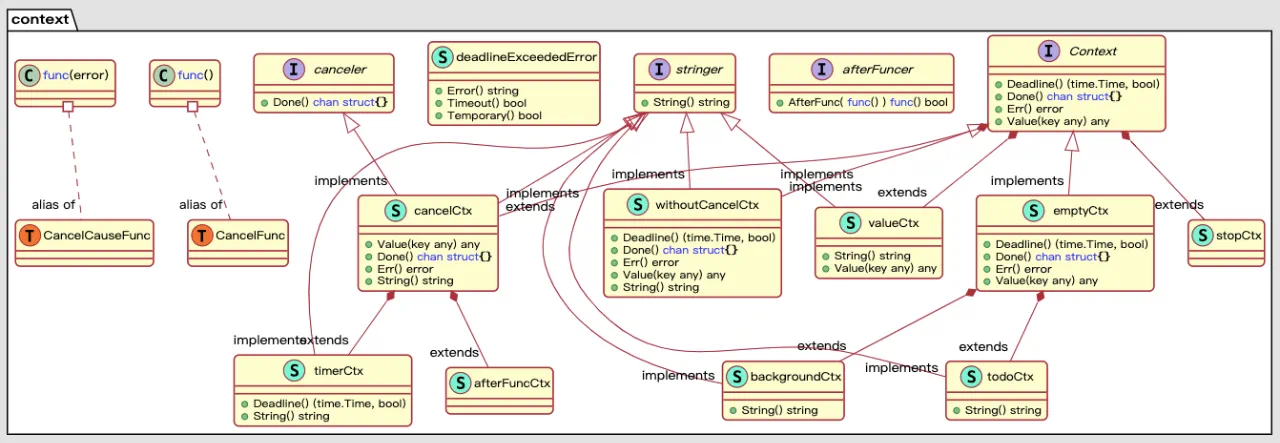**原文鏈接:** [Go 語言 context 都能做什麼?](https://mp.weixin.qq.com/s/7IliODEUt3JpEuzL8K_sOg) 很多 Go 項目的源碼,在讀的過程中會發現一個很常見的參數 `ctx`,而且基本都是作為函數的第一個參數。 為什麼要這麼寫呢?這個參 ...
原文鏈接: Go 語言 context 都能做什麼?
很多 Go 項目的源碼,在讀的過程中會發現一個很常見的參數 ctx,而且基本都是作為函數的第一個參數。
為什麼要這麼寫呢?這個參數到底有什麼用呢?帶著這樣的疑問,我研究了這個參數背後的故事。
開局一張圖:
核心是 Context 介面:
// A Context carries a deadline, cancelation signal, and request-scoped values
// across API boundaries. Its methods are safe for simultaneous use by multiple
// goroutines.
type Context interface {
// Done returns a channel that is closed when this Context is canceled
// or times out.
Done() <-chan struct{}
// Err indicates why this context was canceled, after the Done channel
// is closed.
Err() error
// Deadline returns the time when this Context will be canceled, if any.
Deadline() (deadline time.Time, ok bool)
// Value returns the value associated with key or nil if none.
Value(key interface{}) interface{}
}
包含四個方法:
Done():返回一個 channel,當 times out 或者調用 cancel 方法時。Err():返回一個錯誤,表示取消 ctx 的原因。Deadline():返回截止時間和一個 bool 值。Value():返回 key 對應的值。
有四個結構體實現了這個介面,分別是:emptyCtx, cancelCtx, timerCtx 和 valueCtx。
其中 emptyCtx 是空類型,暴露了兩個方法:
func Background() Context
func TODO() Context
一般情況下,會使用 Background() 作為根 ctx,然後在其基礎上再派生出子 ctx。要是不確定使用哪個 ctx,就使用 TODO()。
另外三個也分別暴露了對應的方法:
func WithCancel(parent Context) (ctx Context, cancel CancelFunc)
func WithDeadline(parent Context, deadline time.Time) (Context, CancelFunc)
func WithTimeout(parent Context, timeout time.Duration) (Context, CancelFunc)
func WithValue(parent Context, key, val interface{}) Context
遵循規則
在使用 Context 時,要遵循以下四點規則:
- 不要將 Context 放入結構體,而是應該作為第一個參數傳入,命名為
ctx。 - 即使函數允許,也不要傳入
nil的 Context。如果不知道用哪種 Context,可以使用context.TODO()。 - 使用 Context 的 Value 相關方法只應該用於在程式和介面中傳遞和請求相關的元數據,不要用它來傳遞一些可選的參數。
- 相同的 Context 可以傳遞給不同的 goroutine;Context 是併發安全的。
WithCancel
func WithCancel(parent Context) (ctx Context, cancel CancelFunc)
WithCancel 返回帶有新 Done 通道的父級副本。當調用返回的 cancel 函數或關閉父上下文的 Done 通道時,返回的 ctx 的 Done 通道將關閉。
取消此上下文會釋放與其關聯的資源,因此在此上下文中運行的操作完成後,代碼應立即調用 cancel。
舉個例子:
這段代碼演示瞭如何使用可取消上下文來防止 goroutine 泄漏。在函數結束時,由 gen 啟動的 goroutine 將返回而不會泄漏。
package main
import (
"context"
"fmt"
)
func main() {
// gen generates integers in a separate goroutine and
// sends them to the returned channel.
// The callers of gen need to cancel the context once
// they are done consuming generated integers not to leak
// the internal goroutine started by gen.
gen := func(ctx context.Context) <-chan int {
dst := make(chan int)
n := 1
go func() {
for {
select {
case <-ctx.Done():
return // returning not to leak the goroutine
case dst <- n:
n++
}
}
}()
return dst
}
ctx, cancel := context.WithCancel(context.Background())
defer cancel() // cancel when we are finished consuming integers
for n := range gen(ctx) {
fmt.Println(n)
if n == 5 {
break
}
}
}
輸出:
1
2
3
4
5
WithDeadline
func WithDeadline(parent Context, d time.Time) (Context, CancelFunc)
WithDeadline 返回父上下文的副本,並將截止日期調整為不晚於 d。如果父級的截止日期已經早於 d,則 WithDeadline(parent, d) 在語義上等同於 parent。
當截止時間到期、調用返回的取消函數時或當父上下文的 Done 通道關閉時,返回的上下文的 Done 通道將關閉。
取消此上下文會釋放與其關聯的資源,因此在此上下文中運行的操作完成後,代碼應立即調用取消。
舉個例子:
這段代碼傳遞具有截止時間的上下文,來告訴阻塞函數,它應該在到達截止時間時立刻退出。
package main
import (
"context"
"fmt"
"time"
)
const shortDuration = 1 * time.Millisecond
func main() {
d := time.Now().Add(shortDuration)
ctx, cancel := context.WithDeadline(context.Background(), d)
// Even though ctx will be expired, it is good practice to call its
// cancellation function in any case. Failure to do so may keep the
// context and its parent alive longer than necessary.
defer cancel()
select {
case <-time.After(1 * time.Second):
fmt.Println("overslept")
case <-ctx.Done():
fmt.Println(ctx.Err())
}
}
輸出:
context deadline exceeded
WithTimeout
func WithTimeout(parent Context, timeout time.Duration) (Context, CancelFunc)
WithTimeout 返回 WithDeadline(parent, time.Now().Add(timeout))。
取消此上下文會釋放與其關聯的資源,因此在此上下文中運行的操作完成後,代碼應立即調用取消。
舉個例子:
這段代碼傳遞帶有超時的上下文,以告訴阻塞函數應在超時後退出。
package main
import (
"context"
"fmt"
"time"
)
const shortDuration = 1 * time.Millisecond
func main() {
// Pass a context with a timeout to tell a blocking function that it
// should abandon its work after the timeout elapses.
ctx, cancel := context.WithTimeout(context.Background(), shortDuration)
defer cancel()
select {
case <-time.After(1 * time.Second):
fmt.Println("overslept")
case <-ctx.Done():
fmt.Println(ctx.Err()) // prints "context deadline exceeded"
}
}
輸出:
context deadline exceeded
WithValue
func WithValue(parent Context, key, val any) Context
WithValue 返回父級的副本,其中與 key 關聯的值為 val。
其中鍵必須是可比較的,並且不應是字元串類型或任何其他內置類型,以避免使用上下文的包之間發生衝突。 WithValue 的用戶應該定義自己的鍵類型。
為了避免分配給 interface{},上下文鍵通常具有具體的 struct{} 類型。或者,導出的上下文鍵變數的靜態類型應該是指針或介面。
舉個例子:
這段代碼演示瞭如何將值傳遞到上下文以及如何檢索它(如果存在)。
package main
import (
"context"
"fmt"
)
func main() {
type favContextKey string
f := func(ctx context.Context, k favContextKey) {
if v := ctx.Value(k); v != nil {
fmt.Println("found value:", v)
return
}
fmt.Println("key not found:", k)
}
k := favContextKey("language")
ctx := context.WithValue(context.Background(), k, "Go")
f(ctx, k)
f(ctx, favContextKey("color"))
}
輸出:
found value: Go
key not found: color
本文的大部分內容,包括代碼示例都是翻譯自官方文檔,代碼都是經過驗證可以執行的。如果有不是特別清晰的地方,可以直接去讀官方文檔。
以上就是本文的全部內容,如果覺得還不錯的話歡迎點贊,轉發和關註,感謝支持。
官方文檔:
源碼分析:
- https://mritd.com/2021/06/27/golang-context-source-code/
- https://www.qtmuniao.com/2020/07/12/go-context/
- https://seekload.net/2021/11/28/go-context.html
推薦閱讀:
- Go 語言 map 如何順序讀取?
- Go 語言 map 是併發安全的嗎?
- Go 語言切片是如何擴容的?
- Go 語言數組和切片的區別
- Go 語言 new 和 make 關鍵字的區別
- 為什麼 Go 不支持 []T 轉換為 []interface
- 為什麼 Go 語言 struct 要使用 tags




